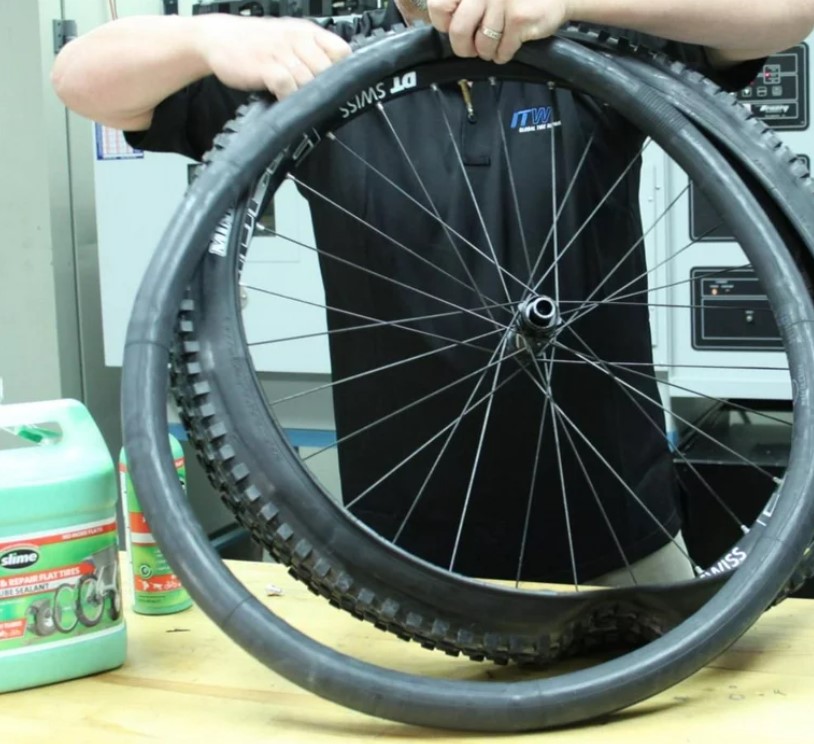Are Self Sealing Bike Tubes Worth It? Quick Answer
In the dynamic world of cycling, one question often emerges: Are Self Sealing Bike Tubes Worth It? This innovation in bike maintenance offers a unique blend of convenience and efficiency. Understanding the value of self-sealing bike tubes requires a deep dive into their functionality, benefits, and potential drawbacks.
Key Takeaways
- Self-sealing bike tubes automatically seal punctures, enhancing ride continuity.
- They are heavier than standard tubes, affecting bike performance.
- Ideal for casual riders and urban commuters.
- May not be suitable for competitive cycling due to weight and rolling resistance.
Are Self Sealing Bike Tubes Worth It?
Yes, self-sealing bike tubes are worth it for cyclists who prioritize convenience and reduced maintenance, particularly for casual riders, commuters, and those cycling in areas with a high risk of punctures.

They offer significant benefits in terms of reducing the frequency of flat tires and ensuring a smoother, more uninterrupted riding experience.
However, for performance-oriented cyclists or competitive racers, the added weight and slight increase in rolling resistance might outweigh these benefits. Ultimately, the value of self-sealing bike tubes depends on the cyclist’s specific needs and riding conditions.
Benefits of Self Sealing Bike Tubes
The allure of self-sealing bike tubes lies in their hassle-free nature. These tubes contain a special sealant that instantly plugs small punctures, often unnoticed by the rider. This feature dramatically reduces the frequency of flat tires, ensuring a smoother, more reliable ride.
Enhanced Reliability
For cyclists, especially those traversing rough terrains or city streets laden with debris, the reliability offered by self-sealing tubes is invaluable. The immediate sealing action means fewer stops for repairs, keeping the journey uninterrupted.
Convenience for Casual Riders
Particularly appealing to casual riders or daily commuters, these tubes provide peace of mind. The added convenience of not having to frequently patch or replace tubes can be a significant time saver, making cycling a more attractive option for daily transportation.
Drawbacks of Self Sealing Bike Tubes
While the advantages are compelling, there are certain drawbacks to consider. The added weight of the sealant can impact the bike’s overall performance, particularly in terms of speed and agility.
Weight and Performance
The additional weight, although minimal, can affect acceleration and climbing efficiency. For competitive cyclists where every ounce counts, this might be a considerable downside.
Rolling Resistance
Another factor is the increased rolling resistance, which can lead to a slight decrease in speed and efficiency. This might not be noticeable for casual riders but could be a deal-breaker for racing enthusiasts.
Comparison with Traditional Tubes
Understanding the value of self-sealing tubes also involves comparing them with traditional bike tubes. Traditional tubes are lighter and often preferred by professional cyclists for their minimal rolling resistance.

Lightness and Speed
The absence of sealant in traditional tubes makes them lighter, offering better speed and agility. This is crucial in competitive cycling where performance is paramount.
Maintenance and Repairs
However, traditional tubes require more maintenance. Riders must be prepared to handle punctures and carry repair kits, which can be inconvenient for those looking for a more carefree riding experience.
Suitability for Different Cyclists
The decision to opt for self-sealing tubes largely depends on the cyclist’s needs and preferences. Casual riders and urban commuters might find the convenience and reliability outweigh the performance drawbacks.
Casual and Urban Riders
For those using bikes for daily commuting or leisurely rides, the self-sealing tubes are a practical choice. The reduced maintenance hassle is a significant benefit for this group.
Competitive Cyclists
Conversely, competitive cyclists might prefer traditional tubes. The performance impact of the additional weight and rolling resistance can be critical in racing scenarios.
Cost-Benefit Analysis
When considering whether self-sealing bike tubes are worth it, the cost plays a crucial role. These tubes are generally more expensive than standard ones, but the reduced maintenance cost and time can be a worthwhile trade-off.
Initial Investment vs. Long-Term Savings
The initial cost of self-sealing tubes is higher. However, considering the savings in terms of repair costs and time, they can be a cost-effective solution in the long run, especially for frequent riders.
Durability and Lifespan
Self-sealing tubes tend to have a longer lifespan compared to standard tubes, which can further justify the higher upfront cost for many riders.
How Long Do Self Sealing Tubes Last?
The lifespan of self-sealing tubes largely depends on usage and the conditions they are exposed to. Typically, these tubes have a comparable lifespan to standard bike tubes when not punctured. In terms of their self-sealing functionality, the sealant inside the tubes remains effective for about two years on average.

However, factors such as the number of punctures sealed, the size of the punctures, and environmental conditions like temperature and humidity can affect this. Over time, the sealant may dry out or become less effective, necessitating replacement or replenishment of the sealant.
For regular cyclists, it’s advisable to check the condition of the tubes periodically and consider replacing them or adding fresh sealant every two years to maintain optimal performance.
Are Self Sealing Bike Inner Tubes Good?
Self-sealing bike inner tubes are generally considered good for certain types of cyclists and specific conditions. They offer the significant advantage of reducing the frequency and inconvenience of flat tires by instantly sealing small punctures.
This feature is particularly beneficial for casual riders, commuters, or those who ride in areas prone to punctures from thorns, glass, or other debris. However, these tubes are slightly heavier and may have a bit more rolling resistance compared to standard tubes.

For leisure cyclists or commuters, these drawbacks are often negligible compared to the convenience of reduced flat tires. For competitive or performance-focused cyclists, the added weight and rolling resistance might be a deterrent.
Ultimately, whether self-sealing bike inner tubes are good depends on the cyclist’s priorities and the type of cycling they engage in.
Why Don’t People Like Self Sealing Inner Tubes?
Despite their advantages, self-sealing inner tubes have certain aspects that some cyclists find unappealing. The main reasons include:
- Added Weight: Self-sealing tubes are heavier than standard tubes because of the sealant inside them. This additional weight can affect the bike’s performance, particularly in terms of speed and agility, which is a significant concern for performance-oriented cyclists.
- Increased Rolling Resistance: These tubes can increase rolling resistance slightly, leading to a reduction in efficiency and speed. While this may not be noticeable for casual riders, it can be a critical factor for racing cyclists.
- Limited Puncture Size: Self-sealing tubes are effective for sealing small punctures but are less effective for larger cuts or holes. This limitation can be a concern in areas where large punctures are more common.
- Drying Out of Sealant: Over time, the sealant in the tubes can dry out, reducing its effectiveness. This requires either replenishing the sealant or replacing the tube altogether, which can be inconvenient and adds to maintenance.
- Cost: Self-sealing tubes are generally more expensive than regular tubes. Some cyclists do not find the cost justified, especially if they do not frequently encounter punctures.
These factors contribute to why some cyclists prefer traditional tubes over self-sealing ones. The choice largely depends on individual preferences, cycling conditions, and priorities regarding performance versus convenience.
Conclusion
In conclusion, self-sealing bike tubes present a compelling option for those valuing convenience and reliability over absolute performance. They are particularly suited for casual and urban riders.
However, for competitive cyclists, traditional tubes might still hold the upper hand due to their lighter weight and lower rolling resistance.
The choice ultimately hinges on the cyclist’s specific needs, riding style, and preferences, making self-sealing bike tubes a worthwhile consideration for many, but not all, in the cycling community.
Frequently Asked Questions
Can the sealant in self-sealing tubes be replenished?
In some cases, the sealant in self-sealing tubes can be replenished by injecting additional sealant into the tube. This can extend the life of the tube and maintain its puncture-sealing effectiveness. It’s important to use a compatible sealant and follow the manufacturer’s guidelines for the best results.
Are self-sealing tubes environmentally friendly?
Self-sealing tubes can be more environmentally friendly than regular tubes in terms of waste reduction. By sealing multiple punctures and extending the tube’s lifespan, they reduce the frequency of tube replacements and, consequently, the amount of rubber waste. However, the environmental impact of the sealant itself varies depending on its chemical composition.
How does temperature affect the performance of self-sealing tubes?
Extreme temperatures can affect the viscosity of the sealant in self-sealing tubes. In very cold temperatures, the sealant may thicken, slowing its ability to seal punctures quickly. In hot temperatures, the sealant might become too thin, reducing its effectiveness. However, most commercial sealants are designed to perform well in a wide range of temperatures.
Can I convert my existing bike tubes to self-sealing tubes?
Yes, you can convert regular tubes to self-sealing tubes by adding tube sealant. This is a liquid sealant that you inject into the tube through the valve. This method allows you to enjoy the benefits of self-sealing technology without purchasing new tubes.

Welcome to the exhilarating world of Matt Rex, a professional car racer turned renowned vehicle enthusiast. Immerse yourself in his captivating blog as he shares heart-pounding adventures, expert reviews, and valuable insights on cars, trucks, jets, and more. Fuel your passion for speed and discover the beauty of vehicles through Matt’s engaging stories and meticulous expertise. Join the ever-growing community of enthusiasts who find inspiration and expert advice in Matt Rex’s blog—a digital hub where the thrill of speed meets the pursuit of knowledge.




![How To Put A Chainsaw Motor On A Bike? [Explained]](https://www.turbochaos.com/wp-content/uploads/2024/01/How-To-Put-A-Chainsaw-Motor-On-A-Bike-768x446.jpg)


